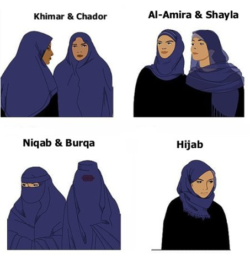Source of article The Jury Room - Keene Trial Consulting.
 In 2014, we wrote about research investigating how people felt when a witness wore a veil such as some forms of a hijab or a niqab. Here were some of the findings we described in that research.
In 2014, we wrote about research investigating how people felt when a witness wore a veil such as some forms of a hijab or a niqab. Here were some of the findings we described in that research.
We’ve written a number of times about bias against Muslims. But here’s a nice article with an easy to incorporate finding on how to reduce bias against your female client who wears a Muslim head-covering. (In case you have forgotten, we’ve already written about head-coverings for the Muslim man.)
The graphic illustrating this post shows the variety of head-coverings Muslim women might wear and the initial findings (as to which head covering style results in the most bias) will probably not surprise you. Researchers did four studies to see how people reacted to Muslim women wearing veils. They consistently found these reactions:
Responses were more negative when the Muslim woman wore a veil of any kind compared to no veil at all.
When the various veils were compared, the niqab or burqa (where only the eyes are exposed or even the eyes are covered) were seen most negatively.
Today’s research goes beyond bias caused by face veils and looks at whether observers are able to detect deception in witnesses wearing veils (as compared to those not wearing veils). The researchers cite three fairly recent (post-2000) cases resulting in judges in the USA, the UK and Canada ruling witnesses cannot wear the niqab when testifying, in part, say the researchers, because they believed it necessary to see a person’s face to detect deception.
The researchers decided to test that assumption by comparing the ability to detect deception when a testifying witness wore a face covering veil versus when the witness did not wear a face covering veil. They ran a study in Canada with 232 participants and then a second study with participants from Canada, the UK and the Netherlands (with a total of 291 participants) and came to a perhaps surprising conclusion. While the detection of deception in unveiled witnesses was no better than chance—the same was not true for those witnesses who wore veils.
“Observers were more accurate in detecting deception in witnesses who wore niqabs or hijab than those who did not veil.”
The researchers say that (contrary to the assumptions underlying court decisions in three countries) the witness who wore a veil did not hamper lie detection—but rather improved it. Why? They make several hypotheses:
Researchers think participants in the “veiled” condition may have interpreted “eye gaze information” more accurately.
Participants had less visual information to attend to and thus were more likely to base their decisions on verbal than non-verbal information.
In short, the researchers think their participants were forced by the situation to rely more on verbal behavior and to focus their attention on the eyes of the witness in the veiled condition. This is actually consistent with the research we’ve covered in our multiple posts on deception detection research. Examples from detection research such as narrowing your focus from multiple cues to just a few or even one cue, examining eyebrows, having certain personality characteristics of your own, how much the witness uses profanity, and even how long it has been since the witness has used a bathroom, and much more are all mentioned in the research as aiding in deception detection. And then there are all of the things jurors often believe point to deception that truly do not help them to identify who is a truth teller and who is a liar.
In this research, the participants could examine eyebrows in the veiled condition and their focus was certainly narrowed so they were less likely to be distracted by irrelevancies—that alone likely improved their ability to detect deception. This is an interesting study that tells us the common reliance we see among mock jurors on non-verbal indicators to detect deception and even the court rulings since 2000 are outdated when it comes to jurors’ ability to detect deception in a witness. Like the researchers say in their article title, less is actually more when it comes to detecting deception.
We made some recommendations to reduce bias against your veil-wearing client back in 2014 and we would still make those recommendations today.
Here they are:
The researchers say that for the least bias, if a religious Muslim woman wants to wear a head-covering, the hijab is likely the best choice. That may, however, not be an option given her religious beliefs.
In either case, this research would say to give jurors information about your client’s choice to wear a Muslim head-covering (of any style) and it will reduce negative assumptions.
The very process of sharing the reasons for wearing a head-covering with jurors, gives them the opportunity for emotional connection with your client. Her sharing reasons for the head-covering allows them to ‘see’ her individuality and religious conviction.
We’d call that both making your client more similar to the jurors (through the use of universal values) and giving jurors an opportunity to see “beneath the head-covering” to the woman herself.
Leach AM, Ammar N, England DN, Remigio LM, Kleinberg B, & Verschuere BJ (2016). Less is more? Detecting lies in veiled witnesses. Law and Human Behavior, 40 (4), 401-10 PMID: 27348716
